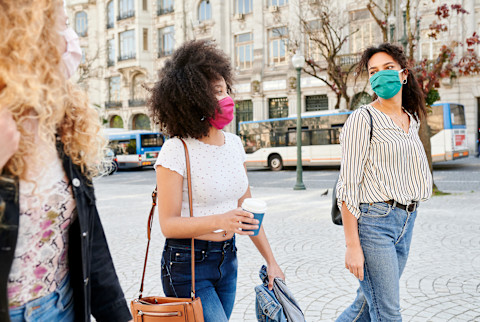The New CDC Guidelines For Going To Restaurants, Gyms & Salons Amid COVID-19

As all 50 states in the U.S. begin reopening, it can start to feel like COVID-19 has been eradicated. Unfortunately, that's not the case. So as lockdown restrictions ease, it's important to make sure safety procedures do not. On Friday, June 12, the Centers for Disease Control (CDC) released new guidelines to help people go out in public1 safely.
The process of reopening restaurants, salons, gyms, and other nonessential businesses is now happening in phases. To find out what phase your state is in, refer to this list or check your local health department's2 website.
Even with the phasing, the CDC says there's no way to ensure zero chance of infection, but there are preventive measures that may help reduce the risk. No matter the public setting, they recommend wearing a face mask or cloth covering and bringing tissues and hand sanitizer with at least 60% alcohol, if possible.
Going to a restaurant.
Some restaurants are open for outdoor dining only, while others are allowing 50% capacity indoors. In either setting, face masks will need to be removed while eating and drinking, but the CDC says it's important to keep them on as often as possible otherwise.
If the people you're dining with don't live in the same household as you, try to maintain a 6-foot distance. And, when it's available, the CDC suggests opting for outdoor seating.
Upon arrival and before leaving, they say to wash your hands for at least 20 seconds with soap and water. "If soap and water are not readily available, use a hand sanitizer that contains at least 60% alcohol," they write. "Cover all surfaces of your hands and rub them together until they feel dry." And always make sure they have ample supplies of soap, paper towels, and toilet paper before going to the restroom.
As much as you may love a salad or hot bar, they suggest choosing food and drinks that aren't self-service. Transmission from respiratory droplets is thought to be the most common, but the CDC says, "It may be possible that a person can get COVID-19 by touching a surface or object that has the virus on it3." Therefore, limiting contact with surfaces, like shared serving utensils, handles, buttons, or touchscreens, may still be helpful.
Going to the gym or fitness center.
Before visiting a gym or fitness center in person, the CDC first recommends looking for virtual fitness classes or training sessions. If you have to go in person, they say to limit group classes and maintain at least a 6-foot distance from those around you.
Make sure all equipment owned by the gym is clean before being used; this includes machines, weights, bands, mats, and other equipment. They recommend using disinfectant wipes for the equipment and hand sanitizer before getting on a machine. If possible, bring your own disinfectant wipes in case the gym runs out.
Breathing in a mask can be difficult, especially while working out. That said, when "exercise type and intensity allows," and social distancing is difficult, it's important to keep them on. These tips for strengthening your lungs may make working out in a mask more manageable.
As tempting as it may be, the CDC says, "Don't shake hands, give high-fives, do elbow bumps, or touch others because close contact increases the risk of acquiring COVID-19."
Going to a salon.
The past few months have led people to cut and color their own hair and practice at-home manicures. If the end result was less than ideal, you may be longing to visit a nail or hair salon. Before you flock there, keep these recommendations in mind:
- Book services ahead of time to reduce time spent waiting. If you do have to wait, do so in your car or outside and have the technician or hairdresser call you when ready.
- Wear a mask at all times, and call ahead to see if the salon's employees are wearing masks.
- Go cashless, if possible. "If not available, ensure that cash and cards are handled with care by employees either by changing gloves between each transaction or with use of hand sanitizer between clients," they say.
- Wash hands before and after services, and avoid touching unnecessary surfaces.
Hosting or attending a social gathering or cookout.
As public businesses begin to open, the idea of hosting large groups of friends and family at home or in the backyard may seem acceptable. After all, you know the people you're inviting to your house better than you know strangers next to you at a restaurant, right?
But the CDC reminds us that no matter how well you know the people, simply "being in a group with people who aren't social distancing or wearing cloth face coverings4 increases your risk."
To reduce the risk, make sure whoever is invited has not been sick within the past 14 days. "Anyone who has had close contact5 with a person who has COVID-19 should also stay home and monitor their health," they write. "Invited guests who live with those at higher risk should also consider the potential risk to their loved ones."
When possible, host the event outdoors or in a well-ventilated room, ask guests to bring and wear face coverings, and make sure you have plenty of soap available.
"If serving any food, consider identifying one person to serve all food so that multiple people are not handling the serving utensils," they say. Otherwise, ask guests to bring their own food, drinks, and utensils. Either way, everyone should wash their hands before and after eating or handling food.
"Consider keeping a list of guests who attended for potential future contract tracing6 needs," they add.
Summary
6 Sources
- https://www.cdc.gov/coronavirus/2019-ncov/daily-life-coping/activities.html
- https://www.cdc.gov/publichealthgateway/healthdirectories/index.html
- https://www.cdc.gov/coronavirus/2019-ncov/prevent-getting-sick/how-covid-spreads.html
- https://www.cdc.gov/coronavirus/2019-ncov/prevent-getting-sick/diy-cloth-face-coverings.html
- https://www.cdc.gov/coronavirus/2019-ncov/php/public-health-recommendations.html
- https://www.cdc.gov/coronavirus/2019-ncov/php/contact-tracing/index.html
